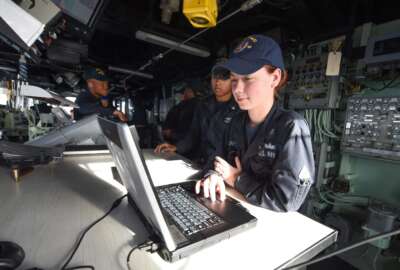
Army PEO-EIS tells industry to straighten up
The acting Army PEO-EIS director says the need for a connected network is getting dire and needs industry to straighten up.
The leader of more than 60 of the Army’s biggest information, warfighting and business programs gave industry a simple message this week: straighten up.
Cherie Smith, acting program executive officer for Army Enterprise Information Systems (PEO-EIS) says she wants industry to come in with solutions, stop exploiting monopolies and to be up front about what they can’t provide, especially when it comes to the Army’s networks.
“I know that you guys got to make a buck and I’m good with you coming in and talking about your capabilities and your products, but I ask that you put that in context with how we can do things better. Open your aperture a little bit so we are better able to take on this new technology,” Smith said during a May 10 C4ISRNET conference in Arlington, Virginia.
Smith made it clear the government is calling the shots and the Army’s priorities are too dire to mess around with industry gimmicks.
“I want to start thinking about how we are doing our contracts,” Smith said. “In some places we are in monopoly-like scenarios. I want to break those monopolies. I’ll use an example in our [enterprise resource planning] world. We are looking at two very large monopolies with SAP and Oracle.”
Smith said she wants companies to come to the Army and explain where their solution doesn’t meet the government’s requirements adequately and to give the Army recommended “bolt-on” solutions so the service can customize.
The Army wants to carve that customization out of the companies taking up the most market space and give the Army the space to flexibly move from one platform to another. Smith said she wants industry to be open about where the Army is not doing something smart.
“I want as much competition as I can drive in my portfolio and still have things run smoothly. I do not want monopolies. I don’t want anybody to be able to come to me and say, ‘I don’t really have to talk to you about what your needs are because I know I got you, you’ve already bought in.’ We are going to make this a flexible network and to do that we need to have the teammates that are willing to be flexible with us,” Smith said.
Smith added during her forthright speech, that the Army doesn’t have time for games from industry either.
“I’m asking you to help with the messaging. If someone asks you about our programs, I just hope that you reach back to our program manager and provide the answer in a coordinated way. If I learn that you’ve been selling a message that’s not quite accurate, I just don’t allow you to come into our building anymore. You’re allowed to go talk to whoever you want in the Pentagon, but you won’t be selling to PEO-EIS face-to-face. … I have too much going on to write the message,” Smith said.
Army PEO-EIS’ sense of urgency and austerity comes from the service’s network situation.
Smith said she thinks in many cases DoD is disconnected and that PEO-EIS struggles constantly to figure out how to provide connectiveness even within its own office.
Data czar
PEO-EIS is looking past networks and into data as well. Smith says the thing that worries her most is data.
“We designed all of our data differently and we’ve set it up according to whatever that functional area is that works best for the logistics, that works best for the network. Nobody has looked across,” Smith said.
Army PEO-EIS is looking into setting up a data czar to handle that function, Smith said the bottom line is the office needs to simplify.
Other areas of the military are also considering a data czar or chief data officer. The Navy has been looking into a chief data officer for more than a year.
“All of that data [we collect] it’s not as though you can hit a button and literally have a database or have a search of ‘Hey, here’s everything related to that,’” said Monica Price Hutchins, who works in strategy and innovation for the Navy chief management officer, describing a similar problem to that of the Army PEO-EIS. “How you actually pull all of that information? That in itself when you can give that use case, when you can give an example to senior leadership that helps them understand not just intellectually, but empirically, this is how we are trying to solve this problem.”
Copyright © 2025 Federal News Network. All rights reserved. This website is not intended for users located within the European Economic Area.
Scott Maucione is a defense reporter for Federal News Network and reports on human capital, workforce and the Defense Department at-large.
Follow @smaucioneWFED
Related Stories




